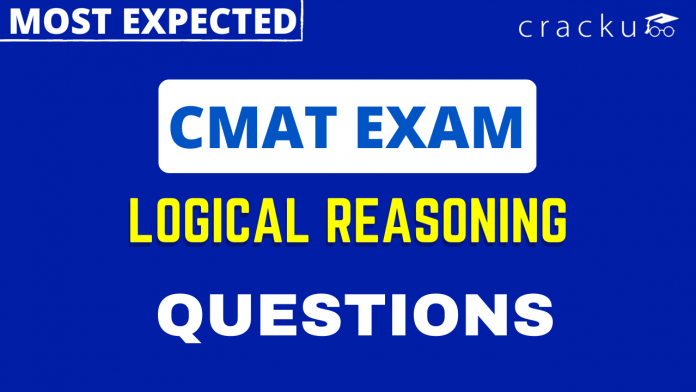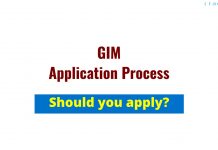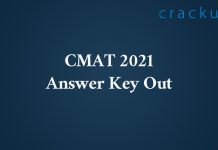CMAT Logical Reasoning Questions [Download PDF]
Download CMAT Logical Reasoning questions with solutions PDF by Cracku. Practice CMAT solved Logical Reasoning Questions paper tests, which are the practice question to have a firm grasp on the Logical Reasoning topic in the CMAT exam. Top 20 very Important Logical Reasoning Questions for CMAT based on the questions asked in previous exam papers. Click on the link below to download the Logical Reasoning Questions for CMAT PDF with detailed solutions.
Download Logical Reasoning Questions for CMAT
Enroll to CMAT 2023 Crash Course
Question 1: Read the following information and answer the question based on it.
A baby has eight stuffed animals and has placed them into groups of two or three. He has separated the monkey, the llama and the dog into different piles. The first pile includes a lion and a mouse. The elephant and the fish are in the same pile. The eighth animal is a turtle.
Based only on the information above, which of the following must be true?
a) The fish and the Illama are in the same pile.
b) The elephant and the turtle are in the same pile.
c) Three animals may be there in the first pile.
d) Exactly two animals are there in the second pile.
1) Answer (C)
Solution:
The first pile has a lion and mouse. As the monkey, the ilama and the dog are in different piles so one among them should be in the first peie.
The elephant and fish are in the same pile and one among monkey, ilama and dog will be in that pile but we cannot say if they will be in 2nd pile or 3rd pile. So there will 2 piles of 3 animals of which one is the first pile.
Question 2: In a certain language, “ba tu qui zu” implies “zomato provides food delivery”. In the same language “ra ni ma tu” implies “i love good food”; “ba te ma so”implies “love the delivery fresh”; and “so zu tu qui ba” implies “zomato delivery provides fresh food”.
What would be the code of “love the fresh” in this code language:
a) qu ra ni
b) te so ma
c) zu so ba
d) tu te qui
2) Answer (B)
Solution:
It is given,
ba tu qui zu – zomato provides food delivery …… (1)
ra ni ma tu – i love good food ….. (2)
ba te ma so – love the delivery fresh …… (3)
so zu tu qui ba – zomato delivery provides fresh food …… (4)
In (1), (3) and (4), code ba and word delivery is common. Therefore, code word for delivery is ‘ba’.
We need to find the code for ‘love the fresh’. Removing delivery from (3), we will get the required answer.
Therefore, code of ‘love the fresh’ includes ‘te ma so’. Only option satisfying is option B.
The answer is option B.
Question 3: A word arrangement, when rearranged by given input follow a particular rule/logic in each step.Following is an example of input and rearrangement. Study that rule/logic and apply on given problem.
INPUT: man’s mood varies with time and environment
Steps/Results:
I. Varies with man’s mood environment and time
II. And time environment mood man’s varies with
III. Environment time and varies with mood man’s
IV. And varies environment time man’s mood with
If Step IV reads, ‘everyone was aware about their beautiful friendship’, what will be the three middle wordsof Step II?
a) their beautiful aware
b) aware beautiful their
c) everyone were friendship
d) aware were beautiful
3) Answer (B)
Solution:
Since the question is only considering the 4th and 2nd lines,
Let us consider the third line of the illustration and arrange the 4th and 2nd lines accordingly.
III. Environment time and varies with mood man’s
Let Environment – 1, time – 2, and – 3, varies – 4, with – 5, mood – 6, and man’s – 7.
Now, the coded version of III will be 1234567.
From the illustration, the code IV will be 3412765 and II will be 3216745.
Now after applying a similar code pattern in Step IV of the asked question, step II will be
Everyone about aware beautiful their was friendship.
Thus, the correct answer is B.
Question 4: Complete the following sequence:
5, 72, 412, 2658, __________?
a) 12772
b) 21264
c) 21512
d) 18876
4) Answer (C)
Solution:
The series is in the form of $2na_n+62\left(n-1\right)\ ,\ n>1$, where $a_1=5$
For n = 2, $a_2=5\times\ 2+62\times\ 1\ =\ 72$
For n = 3, $a_3=72\times\ 4+62\times\ 2\ =\ 412$
For n = 4, $a_4=412\times\ 6+62\times\ 3=\ 2658$
For n = 5, $a_5=2658\times\ 8+62\times\ 4\ =\ 21512$
Thus the correct option is C.
Question 5: In the galaxy “Andromeda”, a planet named “Exo” has a city called “Azith”. The city has analphabet system that consists of 48 letters and an octo-decimal number system (base -18). Theregistration number on the number plate of a vehicle in the city has two parts. The first part is the alphabetpart that consists of three letters and the second part is the number part that consists of 3 digits. The cityadministration issues all kinds of registration numbers with following restrictions:
a. The letters in the alphabet part are in ascending order and all letters must be distinct.
b. In the number part, the first digit is three more than the third digit.
Find the number of possible registration numbers available in the Azith city.
a) 3353270
b) 2557830
c) 5339840
d) 4669920
5) Answer (D)
Solution:
There are 48 alphabets out of which we need 3
So, no. of ways of selecting 3 alphabets from 48 alphabets is $^{48}C_3$
Since we need to arrange these alphabets in ascending order so there is only one possible way for every three alphabets.
The first digit is 3 more than the third digit.
For a particular first digit there will be a particular third digit but the 2nd digit can be any of the numbers
So, no. of ways of selecting first digit= 15
No. of ways of selecting 2nd digit = 18
Therefore, total no. of ways = $^{48}C_3\times\ 15\times\ 18$ = 4669920
Question 6: Based on the information that follows, which of the given options is MOSTDEFINITELY TRUE?
There are two containers in a room.
1. One is a box and one is a can.
2. One is small and is green.
3. One of them has toys in it.
4. The can is big.
5. The container that is completely purple has toys in it.
a) The box is big.
b) The can is green.
c) The box does not have toys in it.
d) The can has toys in it.
6) Answer (D)
Solution:
It is mentioned that there are two containers in a room. One is a box and one is a can.
Can is big. Box is small and green. This implies can is purple and have toys in it.
We do not know what is there in green box.
Therefore, answer is option D.
Question 7: Ranbir’s office has two doors facing each other. The front door faces east. He comesout of his office back door and walks 100 metres, turns right and walks 50 metresfurther. The direction he is now from his office is ______________.
a) North-east
b) South-west
c) South-east
d) North-west
7) Answer (D)
Solution:
The front door is facing east which means that the back door should be facing west.
Ranbir comes out of his from the back door which means he travels in the west direction for 100m and then turns right which means he is now travelling north. So finally Ranbir is in northwest direction from his office.
Question 8: The leap day falls on the same day of the week after a gap of at least ______________.
a) 28 years
b) 7 years
c) 5 years
d) 11 years
8) Answer (A)
Solution:
364 days makes 52 weeks so we will take the remainder days in a year and add them.
For a period of 4 years the no. of days which we get = 2+1+1+1 =5
We have taken a period 4 years as a leap year occurs in every 4 years
Now, we have to make 5 days a multiple of 7 for which we have to multiply it with 7.
So, total years will be 4*7 = 28 years
Question 9: The number of ways in which Aman, Anaya, Danish and Nero can stand in a straightline such that, Danish comes between Aman and Anaya and Nero does not comebetween Aman and Anaya is _________________.
a) 4
b) 6
c) 8
d) 12
9) Answer (A)
Solution:
The possible outcomes will be
Aman, Danish, Anaya, Nero
Anaya, Danish, Aman, Nero
Nero, Aman, Danish, Anaya
Nero, Anaya, Danish, Aman
Question 10: Abeer has 14 novels. Abeer’s friend Sanjay takes 3 of them and gives 2 novels to Abeer. Abeer donates 7 novels but buys 4. Joy takes 4 novels from Abeer and gives him 5. Abeer takes one novel from Sanjay and gives to Joy in exchange for 3 more. Abeer gives those 3 novels to Sanjay and he gives Abeer a novel and a magazine. Rahul takes the magazine which Sanjay gave to Abeer and gives Abeer a textbook. Abeer gives the text book to Joy in exchange for a novel. Rahul takes the novel from Sanjay, gives it to Joy for a magazine and gives Abeer the magazine for a novel. How many textbooks does Abeer have?
1. 0
2. 1
3. 2
4. 3
a) 1
b) 2
c) 3
d) 4
10) Answer (A)
Solution:
In total, Abeer took part in 8 transactions.
0. Abeer had 14 novels.
1. Gave 3 and received 2 novels. Thus, Abeer had 14 – 3 + 2 = 13 novels.
2. Donated 7 and bought 4 novels. Thus, he had 13 – 7 + 4 = 10 novels.
3. Gives 4 to Joy and takes 5. Thus, he had 10 – 4 + 5 = 11 novels.
4. Gets 3 from Joy. Thus, he had 11 + 3 = 14 novels.
5. Gives 3 to Sanjay and gets 1 novel and 1 magazine. Thus, he had 14 – 3 + 1 = 12 novels and 1 magazine.
6. Gives the magazine to Rahul in exchange for a textbook. Thus, he had 12 novels and 1 textbook.
7. Gives the textbook to Joy and takes a novel. Thus, he had 12 + 1 = 13 novels.
8. Gives Rahul a novel and gets a magazine. Thus, he had 13 – 1 = 12 novels and 1 magazine.
Thus, Abeer does not have any textbooks.
Hence, the answer is option A.
Question 11: Direction: A number of sentences are given below which, when properly sequenced, form a COHERENT PARAGRAPH. Choose the most LOGICAL ORDERofsentences from the choices given to construct a COHERENT PARAGRAPH.
A. You may create a visual memory that you can retrace, but physically you cannot experience it again.
B. Now is the only time you have.
C. Nothing is more valuable than the present moment because you can never get it back.
D. Once your past is gone, it doesn’t exist, no matter how many times you recreate it mentally.
E. The future hasn’t even arrived; but again, you keep taking yourself there mentally.
F. Tomorrow comes disguised as today and some of us don’t even notice.
1. AFCEDB
2. DEACFB
3. ABCDEF
4. BDEFCA
a) 1
b) 2
c) 3
d) 4
11) Answer (D)
Solution:
Among the options, only BDEFCA makes a coherent paragraph.
B introduces the topic by saying that the only time we have got is now.
D takes the discussion further by talking about the past.
E then talks about the future thus shifting the discussion towards the things to come.
F furthers the discussion about the future.
C brings the point back to the importance of the present moment.
And finally, A gives more context to the thought mentioned in C.
Hence, the answer is option D.
Question 12: Select the lettered pair that best expresses a relationship similar to that expressed by the original pair.
BROOK : RIVER
a) vein : artery
b) path : highway
c) yard : alley
d) pen : paper
12) Answer (B)
Solution:
“Brook” refers to a small stream, i.e., a smaller version of a river.
Among the options, only “path : highway” represents a similar relationship.
Hence, the answer is option B.
Question 13: Leena, Nitin, Arun and Mohan crossed a lake in a canoe that could hold only two persons. The Canoe held two persons on each of three forward trips across the lake and one person on each of two return trips. Leena was unable to paddle when someone else was in the canoe with her. Nitin was unable to paddle when anyone else except Arun was in the canoe with him. Each person paddle continuously for at least one trip. Who paddled twice?
a) Leena
b) Nitin
c) Mohan
d) Arun
13) Answer (D)
Solution:
On the first trip, Nitin and Arun crossed the river with Nitin paddling the canoe.
Arun came back alone with the canoe.
On the second trip, Arun and Leena crossed the river, with Arun paddling.
Leena came back alone in the canoe.
On the last trip, Leena and Mohan crossed the river, with Mohan paddling.
Thus, Arun is the only one who paddled twice.
Hence, the answer is option D.
Question 14: A census taker approaches a house and asks the woman who answers the door, “How many children do you have, and what are their ages?”
Woman: “I have three children, the product of their ages is 36, the sum of their ages is equal to the address of the house next door.”
The census taker walks next door, comes back and says, “I need more information.” The woman replies, “I have to go, my oldest child is sleeping upstairs.”
Census taker: “Thank you, I now have everything I need.”
What are the ages of each of the three children?
a) 9,2,2
b) 6,6,1
c) 12,3,1
d) 6,3,2
14) Answer (A)
Solution:
It is given, product of their ages is 36.
Possible combinations are:
1*1*36 – sum = 38
1*2*18- sum = 21
1*3*12 – sum = 16
1*4*9 – sum = 14
1*6*6 -sum = 13
2*2*9 – sum = 13
2*3*6 – sum = 11
3*3*4 – sum = 10
The census takers comes back and ask for more information implies that the sum is 13. There are two possibilities for only sum 13, as there are two possibilities census taker comes back and asks for other clue.
(1, 6, 6) or (2, 2, 9)
The woman says her oldest child is sleeping upstairs. Therefore, the ages will be (2, 2, 9).
The answer is option A.
Question 15: Find the ODD one out from the group of words which are 87. related in some way or the other
a) din
b) cacophony
c) racket
d) cadence
15) Answer (D)
Solution:
Options A, B and C all mean a loud, unpleasant noise.
Option D means a pleasant sound.
Hence, the answer is option D.
Question 16: Two Statements are followed by two conclusion I and II. Mark your answer as:-
Statement:
All students in my college are intelligent.
Rahul is not intelligent
Conclusion:
I. Rahul is not from my college.
II. Rahul should study more.
a) if only Conclusion I follows
b) if only Conclusion II follows
c) If both I and II follow
d) If Neither I nor II follows.
16) Answer (A)
Solution:
As per the two statements, we can only conclude conclusion I and whether Rahul should study more or not we cannot infer from the above statements.
Question 17: The roads to travel to various cities from point A are as given.
I, J and K can be reached only from E. E cannot be reached from D or C. A leads to B and from C, you can reach G. B leads to E. D can be reached from C. D leads to F. G also leads to F. L can be reached only from G via F. M can only be reached from D via F. All distances between two places are 1 km. All ways are one-way only.
To reach M, one must have travelled through?
a) G and F
b) C and D
c) B
d) B and K
17) Answer (B)
Solution:
Using the conditions given in the question, the path diagram is as given below.
_RFyxnNG.png)
To reach M, the path is C-D-F-M.
Thus, one must have travelled through C and D to reach M.
Hence, the answer is option B.
Question 18: The roads to travel to various cities from point A are as given.
I, J and K can be reached only from E. E cannot be reached from D or C. A leads to B and from C, you can reach G. B leads to E. D can be reached from C. D leads to F. G also leads to F. L can be reached only from G via F. M can only be reached from D via F. All distances between two places are 1 km. All ways are one-way only.
If one reaches D, one can go to?
a) F and M Only
b) F only
c) J and G
d) F and L
18) Answer (A)
Solution:
Using the conditions given in the question, the path diagram is as follows.
_ajQMfuR.png)
From D, one can only go to F and to M.
Hence, the answer is option A.
Question 19: Which of the following shall come in place of missing ‘- ‘?
m n o n o m – m – m n o – o –
a) mnoo
b) onnm
c) mnno
d) mnom
19) Answer (B)
Solution:
The first three letters (m n o) becomes (n o m) the next three letters. Similarly, now (n o m) becomes (o m n).
So the missing letters are (o n n m)
Question 20: The roads to travel to various cities from point A are as given.
I, J and K can be reached only from E. E cannot be reached from D or C. A leads to B and from C, you can reach G. B leads to E. D can be reached from C. D leads to F. G also leads to F. L can be reached only from G via F. M can only be reached from D via F. All distances between two places are 1 km. All ways are one-way only.
I, J and K can only be reached from?
a) A
b) E
c) C
d) B
20) Answer (B)
Solution:
Using the conditions given in the question, the path diagram is as given below.
.png)
Thus, I, J and K can only be reached from E.
Hence, the answer is option B.





